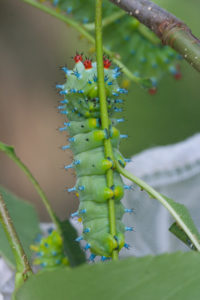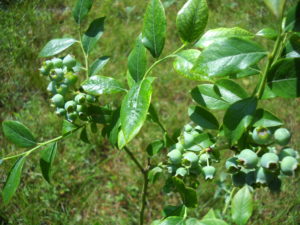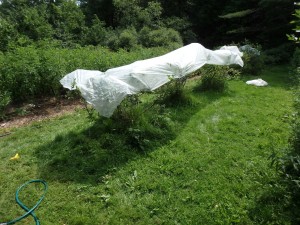Trees and Shrubs Are Important for Pollinators
When I say “Pollinator”, you think bee, right? Honeybee, bumblebee, wild bee. But what about moth, butterfly, beetle or fly? Many of those are pollinators, too. I recently read an interesting article about pollinators by Dan Jaffe and Jane Roy Brown in the “Native Plant News,” a magazine put out by the New England Wild Flower Society.
The authors’ basic premise is that moths and butterflies are the unsung heroes of pollination, and important part of a balanced ecosystem. Of the 700 or so species of butterflies and moth (Lepidopterans) found east of the Mississippi, 500 species are supported by five native trees: oaks, cherries, willows, birch and poplar or aspen. In comparison, our perennial flower bee balm (which is loved by bees) supports just 11 species of butterflies and moths.
I called Dan Jaffe and asked this: what is the value of Lepidopterans to the average gardener? Can’t bees take care of our fruit trees and veggies? Yes, he said, bees are great pollinators, but butterflies and moths feed our baby birds – and birds are great at controlling insect pests and moving seeds around the landscape to create a biologically diverse environment.
It works like this, he said. Baby birds need a high protein diet, so parent birds serve them caterpillars as 95% of their diet, even birds that are seed eaters as adults. If there are no caterpillars, fewer baby birds will survive. And, he noted, our native species of trees are much better at feeding them than introduced decorative species.
Many butterflies and moths depend on specific species of plants to survive. Most of us know about monarch butterflies: they only will lay their eggs on milkweed. As adults, however, the monarchs will feed on many flowers including asters, goldenrod and a variety of other flowers. The endangered Karner blue butterfly depends on sundial lupine (Lupinus perennis) – and will not even feed on other related lupines. Planting to support specific butterflies is a worthy endeavor.
Dan Jaffe emphasized to me that planting native species is important: they are trees and shrubs that evolved with our butterflies and moths, so that is what they are programmed to find and eat. Native trees and shrubs provide the leaves needed to feed caterpillars and to make their chrysalises. Pollinators need not just pollen, but food and habitat throughout their life cycles.
According to the article by Jaffe and Brown, willows are “the unsung heroes of the lepidopteran world.” The native black willow (Salix nigra) supports over 400 different species of butterflies and moths. I planted one 25 years ago near my brook and it is now a full-sized tree, perhaps 35 feet tall and 25 feet wide. Early on I kept it pruned as a shrub, but I skipped pruning for a couple of years – and it became a tree!
I also grow three kinds of pussy willows, including our native one, Salix discolor, which grows wild along my stream. I also grow rosemary willow, a curly willow, and a variegated-leafed, non-native willow (Salix integra ‘Hakuru nashiki’). All of those have stayed under 20 feet tall and thrive in the sunny moist area near my stream.
All my willows are fast growing and some will spread by root, although the rosemary willow (Salix elaegnos) has not spread. The rosemary willow has leaves that look almost identical to rosemary leaves. I have to admit that, until now, I had never thought of willows as food for caterpillars or adult butterflies.
Also mentioned in that article are the cherries. They support some 400 species of butterflies and moths. I have a huge black cherry (Prunus serotina) growing next to my house and overhanging my deck. It was there as a large tree when I bought my house 49 years ago, and is huge now – 60 feet tall or more, and the trunk is 4 to 6 feet in diameter at its base. I see lots of caterpillars on it each summer, and butterflies around it. Still, it is a messy tree dropping berries, leaves and twigs. I wish it were elsewhere on the property, but I won’t cut it down.
Choke cherry (Prunus virginiana) is common in disturbed areas as a shrubby volunteer growing in full sun and poor soil. It is often a multi-stemmed shrub that blooms in May or June with small white flowers followed by red berries in July and August. Again, it supports pollinators with nectar, pollen, and leaves to munch on – and birds like the berries, too.
One last plant to consider for pollinators and birds is the ordinary blueberry. It has lovely flowers in June, berries we all like later, and colorful leaves in fall. So what if the birds get most of the berries? Consider it your part of supporting a diverse and healthy ecosystem – including some 294 species of butterflies and moths.
To learn more about native plants, visit the Garden in the Woods in Framingham, MA next spring, where you can buy native plants. Visit their web site now, http://www.newenglandwild.org, for more information.
Henry can be reached by e-mail at henry.homeyer@comcast.net. He is a lifetime Master Gardener and the author of 4 gardening books. He lives and gardens in Cornish Flat, NH.
Are Blueberries For the Birds? Or For Us?
I gave a lecture and slide show recently about good plants that support our feathered friends. I talked about good habitat for nesting and safe places to rest while avoiding cats. But when I showed plants birds like to eat, some gardeners were surprised when I showed blueberries: they didn’t want to share. Many of those same people buy black oil sunflower seeds in 50 pound bags every month all winter. But share the blueberries? No way. If you don’t want to share, let’s look at the options.
Years ago when I was in the category of “blueberries are for me, not the birds” I developed an easy netting system that kept the birds off – but I no longer use it. Netting allows the birds to see those ripe berries, taunting them if you will, and some will get caught in the netting trying to get in. A friend recently reported finding 3 dead and rotting birds in the blueberry netting of a friend who was away. I haven’t used nets in years.
But let’s assume you want to net and are willing to check the nets frequently for caught birds. I suggest using tall plastic hoops that will allow you to drape wide swaths of netting over the bushes and easily slide it off to pick.
Buy 10 foot lengths of PVC pipe that is ¾ inches in diameter. For smaller bushes, cut some pipes in half and glue them to full length pieces to produce 15 foot long pipes. For large mature bushes, use 2 full lengths. Every 10 feet of a row of blueberries needs a hoop. Just bend the pipe to make a hoop, and push into the soil. I kept the netting in place with hair clips, the kind with 2 rows of teeth and a spring. On the ground I used landscape staples to hold the netting down and keep birds out.
I called my buddy Chris Dye of Noda’s Blueberry Farm in Meriden, NH (www.nodafarm.com). He said they bought a noise maker to keep the birds at bay. It’s called a Bird Gard Pro. (http://www.birdcontrolpro.com
Then I called Riverview Farm in Plainfield, NH and talked to Nancy Franklin. She and her husband have a huge fruit operation – apples, blueberries, raspberries, pumpkins and more (http://www.riverviewnh.com/). Nancy said that their berries are mostly late-season varieties, especially one called ‘Elliot’. By the time they are ripe, many of the bird culprits are getting ready to migrate and have changed their feeding habits, and are less of a problem. So they share a few, but don’t lose too many.
One problem with late-season berries whether blueberries, raspberries or strawberries is a new pest that arrived a few years ago: the spotted winged drosophila, a foreign fruit fly. Unlike our native fruit flies, this one attacks good fruit, not rotten fruit. So I don’t recommend any late season varieties until someone develops a predator insect that will control this new pest.
Birds evolved to avoid large predatory birds like owls and hawks. So you can buy a plastic owl and put him out in your blueberry patch, but birds aren’t stupid. Unless you are going to move it from tree to tree, they’ll figure out it’s not real.
Birds don’t like shiny things, either. I’ve known gardeners to hang old music CD’s they no longer enjoy in the bushes. The wind blows them, and they shine light at the birds. But then again, in time, they might start rocking to “Grandma Got run Over by a Reindeer” instead of flying away.
I also have some Nite Guard Repellent tape. This is shiny tape designed to scare birds with movement, noise and light (http://www.niteguard.com/). At $15 for a 100 foot roll, it is affordable – and probably helps.
I have a bumper crop of blueberries ripening up now on my 7 bushes. I attribute that to the fact that I have been spreading agricultural sulfur around the bushes for a few years, getting the soil very acidic. Soil pH is very important, and you can add sulfur any time. But don’t add acidic fertilizer now (Holly-Tone, for example) as that should be done in early June. Fertilizer now would stimulate new growth which could easily be damaged in winter.
So this year I decided to put Reemay or “row cover” over my bushes. It’s a light-weight agricultural fabric designed to keep bugs off crops. I keep it in place with ordinary wooden clothes pins. It only cover the top of the bushes, or a little of the sides, but birds flying over won’t see it. And if my resident robins want to go on the ground and pick up berries, why not? There is nothing to harm the birds, and it is an inexpensive, quick–to-install solution. So put me in the category of “willing to share – a little – with the birds.”
See Henry’s twice-a-week blog at www.dailyuv.com/gardeningguy. He is the author of 4 gardening books, and a lifetime UNH MasterGardener.







